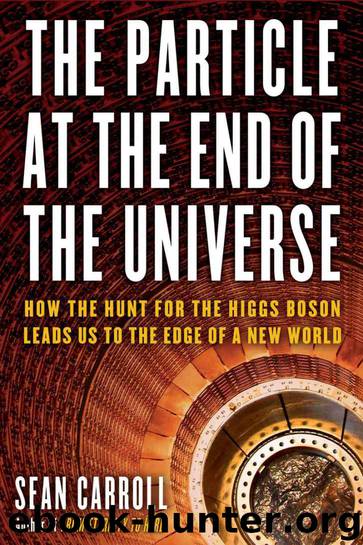The Particle at the End of the Universe: How the Hunt for the Higgs Boson Leads Us to the Edge of a New World by Carroll Sean

Author:Carroll, Sean [Carroll, Sean]
Language: eng
Format: epub, mobi
Publisher: Penguin Group US
Published: 2012-11-12T23:00:00+00:00
What comes out
So you’ve made a Higgs boson! Congratulations. Now comes the tricky part: How are you ever going to know?
Heavy particles tend to decay, and the Higgs is very heavy indeed. The lifetime of the Higgs is estimated to be somewhat less than a zeptosecond (10-21 seconds), which means it gets to travel less than a billionth of an inch between when it’s produced and when it decays. Even with the very advanced detectors inside ATLAS and CMS, there’s no way we’re seeing that. Instead, we see what the Higgs decays into. We will also see things that other non-Higgs particles decay into, many of which look just like what the Higgs decays into. The trick is to pick out the tiny signal from the huge amount of background noise.
The first step is to figure out exactly what your Higgs is going to decay into, and how often. In general, the Higgs likes to couple to heavy particles, so we might expect it to decay frequently to top and bottom quarks, W and Z bosons, and the tau lepton; not so much to lighter particles like up and down quarks or electrons. And that’s basically right, although there are subtleties (as you knew there would be).
For one thing, the Higgs can’t decay into something that’s heavier than it is. It can temporarily convert into heavy virtual particles that themselves quickly decay away, but processes like that become very rare if the virtual particles are much heavier than the original Higgs. If the Higgs were 400 GeV, it could readily decay into a top quark and an antitop, which come in at 172 GeV each. But for a more realistic Higgs mass like 125 GeV, top quarks are unavailable, and bottom quarks are the favored decay mode. That’s one reason why heavier versions of the Higgs (up to 600 GeV) would have actually been easier to find, even though it takes more energy to create them—the rate of decay into heavy particles is much higher.
The figure shows a pie chart giving the approximate ratio of different decay modes for a Higgs boson with a mass of 125 GeV, according to the Standard Model. The Higgs will decay into a bottom quark and an antibottom most of the time, but there are a number of other important possibilities. Although this value for the Higgs mass makes it hard to detect, once we do there’s a tremendous amount of interesting physics to be studied—we can measure each decay mode separately and compare it with the predictions. Any deviation would be a sign of physics beyond the Standard Model, such as additional particles or unusual interactions. We’ve even seen hints that such deviations might actually exist.
Download
The Particle at the End of the Universe: How the Hunt for the Higgs Boson Leads Us to the Edge of a New World by Carroll Sean.mobi
This site does not store any files on its server. We only index and link to content provided by other sites. Please contact the content providers to delete copyright contents if any and email us, we'll remove relevant links or contents immediately.
| Atomic & Nuclear Physics | Particle Physics |
The Complete Stick Figure Physics Tutorials by Allen Sarah(7310)
Secrets of Antigravity Propulsion: Tesla, UFOs, and Classified Aerospace Technology by Ph.D. Paul A. Laviolette(5310)
Thing Explainer by Randall Munroe(3877)
The River of Consciousness by Oliver Sacks(3542)
The Order of Time by Carlo Rovelli(3145)
How To by Randall Munroe(3036)
A Brief History of Time by Stephen Hawking(2962)
I Live in the Future & Here's How It Works by Nick Bilton(2938)
The Great Unknown by Marcus du Sautoy(2648)
What If?: Serious Scientific Answers to Absurd Hypothetical Questions by Randall Munroe(2637)
Midnight in Chernobyl by Adam Higginbotham(2483)
Blockchain: Ultimate Step By Step Guide To Understanding Blockchain Technology, Bitcoin Creation, and the future of Money (Novice to Expert) by Keizer Söze(2450)
Networks: An Introduction by Newman Mark(2360)
The Meaning of it All by Richard Feynman(2300)
Easy Electronics by Charles Platt(2282)
The Tao of Physics by Fritjof Capra(2231)
Midnight in Chernobyl: The Untold Story of the World's Greatest Nuclear Disaster by Adam Higginbotham(2177)
When by Daniel H Pink(2083)
Introducing Relativity by Bruce Bassett(2080)
